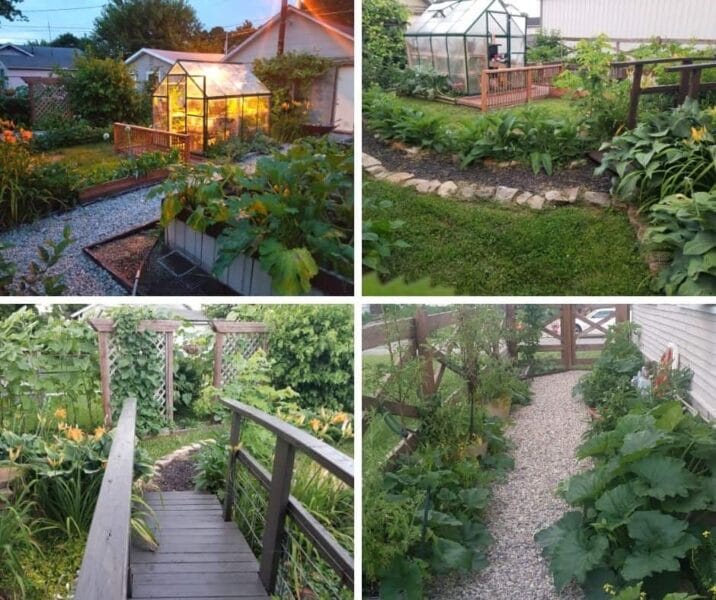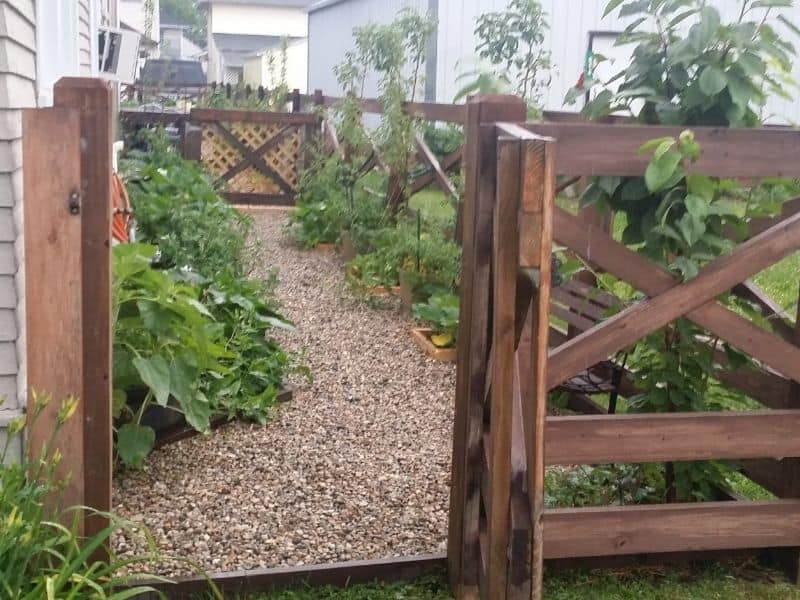
Small yards are not an excuse to not pursue your homesteading dreams. You can do a lot in a small space and in an urban environment.
This property tour is about 5 years into our homesteading journey, recorded in 2018, and even though we are several years past this now, it shows the possibilities.
Watch The Video Tour
“Let us develop the resources of our land, call forth its powers, promote all its great interests, and see whether we also, may not perform something worthy to be remembered.”
― Daniel Webster
Evaluate Your Property
No matter where you live, you can homestead! However, what you can do on your homestead may be determined or limited by where you live. Here’s how to evaluate your property to determine the possibilities and limitations that will help you decide what homesteading will look like for you.

for a deep dive into what this flow chart lays out.
Maybe you are in a home in the city on a small lot with a small backyard, perhaps with unfriendly city ordinances toward some of the things you may want to do. This certainly is not an ideal situation, but a common one and also one that shouldn’t keep you from homesteading.
“Complaining is not a strategy. You have to work with the world as you find it, not as you would have it be.”
― Jeff Bezos
Ways To Get Ordinances Changed
• Find likeminded folks in your town that feel the same way you do and come together to make changes.
• Try to identify people on your city council who will work on your behalf to make these changes.
• Be informed. Find ordinances from another city that allow for livestock and gardens for comparison.
• Start a petition to get the law or ordinance changed.
• Get familiar with the procedures of your local government by attending council meetings and getting to know local politicians.
Doing these simple things will help you to make the changes that need to be made to allow you and others the freedom to live the way you should be able to live. However, even if you can’t get these changes made, there will be many things you can still do on your property to pursue the homesteading lifestyle but get the ball rolling with your local government anyway if there are restrictions.
Look At What You Can Do By Evaluating What You Already Have.
Our property before we started homesteading was a standard 1/10th acre city lot that was growing nothing but grass.
The property on the bottom of the photo under the fence line was our land at the time. We acquired the property on the right with the barn a few years later. As you can see, we didn’t have much to work with when the majority of our property was taken up by the house and garage.

Clear South Facing Land For Gardening
Gardens require plenty of sunlight, so if you plan on having a garden, you need to evaluate your property for the proper amount of light. In the northern hemisphere, this will more than likely be a south-facing part of your property away from outbuildings and tall trees.
Places For Trees That Won’t Shade Out Gardens
Generally, a place north of a garden area is a great place to grow trees, specifically fruit trees, not only because they will provide you with an abundance of food but also will draw in pollinators. Also, look on your property for ornamental trees that could possibly be replaced by a food production tree, whether fruit or nut.
Good Shade
Having some shade is good if it’s in the right places. Providing shade for livestock is a plus, especially in warmer climates. Whether your livestock are small or large, they will appreciate a place where they can escape the direct sunlight for a few hours a day.

Having spotty shade for some crops also is great to have. I intentionally planted a row of fruit trees south of a garden on the south side of my house because it was too hot for the plants there. By spacing out the trees, it allows for breaks in the direct sunlight but also provides them with enough sunlight throughout the day to grow well without burning up and withering in the sun.
Soil Quality
How is the soil on your property? Is it hard and compacted? Is it clay-based? Is it made up of “fill dirt” with lots of rock and possibly other unwanted particles? Maybe it’s near perfect, dark, rich, loamy soil, and you won’t have to do much to it at all. All these things are necessary to know about your property so you can know which direction to go.
You may want to start by getting a soil test. These can usually be done at your local County Extension Office. These tests will tell you what deficiencies you have in your soil; they will also tell you if you have any heavy metals present you need to be concerned about.
No matter what your soil type or soil problems, there are things you can do to correct or overcome the problem. Amending the soil may take a little time, energy, and resources, but in the long run, it’s worth it. In extreme cases, bad soil can be overcome by building raised beds and bringing in new soil.
Water Access
Having access to good water is extremely important for your homestead, for your garden, your livestock, and you. Access to well or municipal water is where you’re probably going to begin. Municipal water supplies have a lot of problems for drinking, so I recommend a good water filtration system like a Berkey that filters out nearly all of the bad things. Wells can also have problems, so get your water tested regularly.
- ENJOY GREAT-TASTING TAP WATER EVERY DAY AT HOME- The 3.25-gallon Royal Berkey...
- INDEPENDENT TESTING- Black Berkey Elements (the original BB9-2) are composed of...
- INCLUDES AUTHENTIC BLACK BERKEY ELEMENTS (THE ORIGINAL BB9-2)- Don't fall for...
Last update on 2024-07-26 / Affiliate links / Images from Amazon Product Advertising API
Water Collecting
Rainwater collection is a great way to go for watering gardens and livestock. If you have gutters on a house, barn, or other outbuildings, you can set up a rainwater catchment system that can provide you with all your homesteading water needs.
Water Drainage
Evaluating your property for poor drainage is important as well. Unless your growing rice, most crops don’t do too well in standing water, nor do livestock.
Knowing how water flows into and across your property will be valuable information. This will help you decide how you will control that flow and utilize it in a way that will benefit your homestead. Many properties, especially urban and suburban, are set up to divert or drain water as quickly as possible.
A properly designed property will be set up to utilize that water for the land. You may decide to put in swales on your property to slow down and control the water flow and make use of the water while allowing for maximized growing space. A swale is a ditch on the contour of a property that holds water and slowly releases it back into the land.
Wind
Perhaps you think this isn’t something you need to think about, especially if you live in more condensed areas, but those who homestead in wide-open spaces understand the struggles with the wind.
Wind can damage crops, infrastructure, and make for some brutal winters. Evaluating the wind situation on your property can help in homestead design. Consider where to place gardens to minimize wind damage and plant trees strategically to provide wind blocks. Outbuilding can also be purposefully placed for wind blocks that will benefit your homestead.
Outbuildings
What outbuilding do you already have? Are they in the right places? Can they be used for something other than their original intended purpose? Are there places to put other outbuildings such as sheds and coops and greenhouses?

Fencing
Good fences serve all kinds of purposes, and it’s important to evaluate the fence situation on your property. Do you already have fences? Are they in good shape and in the right places? Are there places where you need to put fencing?
Fences can provide very useful infrastructure as they can provide security, privacy, trellises, and make homestead life easier in many ways. But only if it’s the right kind of fence in the right place.
Places For Adding Other Infrastructure
Do you have room for other infrastructure such as a compost bin or perhaps an outdoor cold smoker? Evaluating your property for the possibilities of future building projects will help you make plans for your homestead as you grow and help you to understand your possibilities as well as your limitations.

Neighbors
What are your neighbors like? Good neighbors are worth their weight in gold; bad neighbors can ruin your life and make you miserable. Knowing this will help you make possibly hard decisions about your homestead going in. It will help you decide what kind of security or privacy you may need for your homestead.
Places For Food Storage
Root cellars, basements, or just a large cupboard can provide a place for storing canned goods and root vegetables. Do you have such places on your property already, can you have such a place? The answer is probably yes in nearly all cases, which shows that nearly any place can be made to accommodate some aspects of a homestead.
Places For Food Preparation
Do you have a kitchen? I’m guessing you do, and that’s why I wanted to point this out. So many overlook the importance of this homesteading skill, but they shouldn’t, and you can do it no matter where you live.
Just Get Started
The journey of a thousand miles begins with one step.
Lao Tzu
It may seem overwhelming but you can do it! My journey began with one small raised bed garden bed growing some salad greens. Your journey can begin with something just as simple. Just get started.




